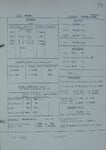Shortround6
Lieutenant General
Reason(s) for not using increased fuel tankage from 1940 on is well known - it was then-current doctrine of the RAF. That myopically stipulated the long-range fighter will always be inferior to a short-rage enemy fighter, without looking at big picture.
That myopic view wasn't as far off as you seem to think in 1940-41.
The US bombers weren't there in usable numbers.
The British bombers, for daylight bombing, had some serious issues.
The British were just figuring out the possibility of 100/130 fuel.
The British bombers in 1940-41 are going to flying lower and slower than the US bombers did in 1942-43 making them a much better target for flak, (which was less numerous and had less radar in 1940-42). It took quite while for the British to get up to 15lbs boost on the Merlin 45 or 14/16lbs boost on the Merlin XX series. So escort Spit (or British plane X) is using a Merlin that maxes out at 12lbs or less? Granted the Germans had some trouble using higher than 1.3 Ata boost but the British may not have known that or when it would be fixed.
The 109F-4 shows up in the summer of 1941. Spit V with 25-30 gallons of extra fuel (inside) plus drop tank running 12lb boost vs the F-4 at 1.42 ata? escorting Wellingtons?
Not a pretty picture.


